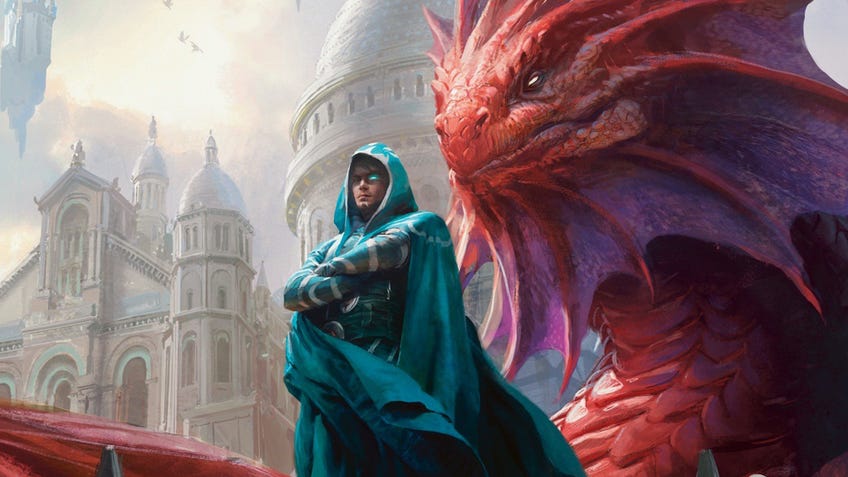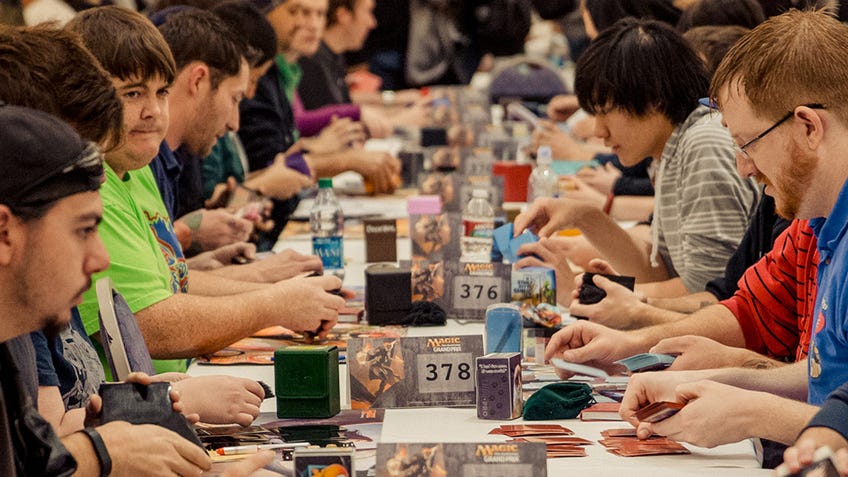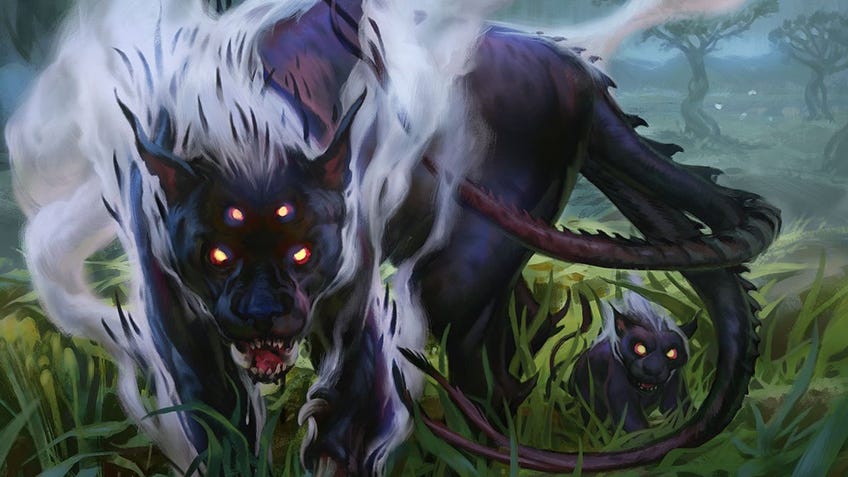How to play Pioneer in Magic: The Gathering
Standard's rotation a pain? Modern too pricey? Get started with one of MTG’s newest - and most accessible - formats.
If you’ve been playing a lot of Magic: The Gathering, the chances are that you’ve heard of Pioneer, but maybe you haven’t played it yet or even looked into it that much. A lot of players stick with Standard for a while and put up with the fact that the cards you love will end up going away when sets rotate out. It doesn’t have to be that way, though - learning how to play Pioneer is a great way to start your foray into the other popular MTG formats.
How to play Pioneer MTG
- What is Pioneer?: Find out what makes Pioneer tick.
- When did Pioneer start?: Pioneer is a relatively new MTG format - here’s when it started and why.
- How do you play Pioneer in MTG?: Learn the rules and set legality of Pioneer.
- How to build an MTG Pioneer deck: Figure out the best way to put together your own deck.
- How to find decklists for MTG Pioneer: Find out how to discover the top tier decks in the format.
Modern used to be the next step for players who became bored of Standard or started to miss their favourite cards, but it’s become rather pricey as it's gone on. Pioneer is an excellent midway point between Standard and Modern, but it’s also a great format to enjoy even if you’ve been playing other formats for ages now.
What is Pioneer?
Pioneer is a Magic: The Gathering format that feels as though it was designed to be a halfway point between Standard and Modern. It’s easy to think of Standard as a gateway into older formats, but it’s not actually that easy to make that transition because of the high costs of what most consider essential Modern cards. We’re talking about cards such as the fetch lands and some of the planeswalkers and creatures that go into the top-tier Modern decks.
If MTG as a whole is a journey, then most people start at home, playing kitchen table Magic, before setting off into the wilds of Standard. You’ll hunt around there for a while before going onto bigger things like Modern, and Pioneer is a halfway house for you to rest in on the way.
That’s not to say there’s not a lot of fun to be had in the format at all. It’s just the way that Pioneer feels for many players. It’s one step more complex than Standard, but it’s nowhere near as expensive as Modern generally is - although you can make Modern a lot cheaper if you know how.

When did Pioneer start?
Pioneer is still very much in its infancy. In fact, for a little while after it was introduced in late 2019 there was an announcement on new card bannings every week up until January 6th 2020. Despite the talent over at Wizards of the Coast, it’s impossible for them to keep up with the way that MTG players as a whole think, and that meant there was a lot of utterly absurd stuff going on in the early days of Pioneer.
The format was first announced in October 2019, but it actually got officially codified on January 30th 2020 thanks to a showing at Grand Prix Brussels. Because the format is so young you won’t find as many players with Pioneer decks lying around, but it’s likely to keep growing once paper Magic becomes more common again.
How do you play Pioneer in MTG?
Pioneer has the same rules as most of the constructed formats in MTG. That means you need a minimum of 60 cards in your main deck, with a maximum of four copies of any single card outside of basic lands and a few cards that state otherwise, such as Rat Colony. You can also have a sideboard with up to 15 cards which you can use to alter your deck in-between matches one, two and three against specific opponents.
On top of that, the cards that are legal in Pioneer are those that were printed in regular sets or expansions from Return to Ravinca onwards, with the exception of anything on the Banned List for the format.
One of the key things to keep in mind with Pioneer is that none of the traditional fetch lands - including Polluted Delta, Bloodstained Mire and so on - are legal in the format.This is presumably to help keep the cost lower and make the format more accessible to those who’ve set their MTG sights away from Standard.

How to build a Pioneer deck
As is always the case when building a new MTG deck, the first thing you’ll need to do is decide what kind of deck you want to play. There are lots of different playstyles to consider, but most of the fall into aggro, midrange, control or combo.
Generally speaking, it’s easiest to pilot an aggro deck because the aim is nearly always to simply turn your creatures sideways and hit your opponent fast and hard. If you prefer bigger creatures and more complicated play then you’ll likely want to consider a midrange deck. If you enjoy messing with opponents then a control deck is a great shout. Finally, if you prefer to play obnoxiously complicated decks that can potentially end the game before your opponent has even cast a spell, then you’ll want a combo deck.
If you want to have a go at building your own Pioneer deck then there are some rules to keep in mind. The first thing to do is to consider which mana colours your deck is going to be in, then have a think about how many land cards you’ll need to support the mana curve you’re going to have. Generally speaking, you’ll want somewhere between 20 and 26 land cards in your deck. Due to the lack of fetch lands in the format, going for more than two colours is risky. It’s not impossible, but it’s going to hurt your chances of playing the cards you want or drawing the right lands.
After that, the specific card types you’ll put into your deck are down to your strategy and deck type. We can’t give you a formula for this, but we do recommend play-testing your deck a lot to figure out which cards do things and which cards often don’t. The easiest way to do this is to keep in mind which cards you’re not often happy to see. If a card doesn’t bring you joy when you draw it, the chances are that it either belongs in the sideboard or in the bin. (Not the actual bin, but you know what we mean.)
Finally, you need to consider your mana curve. This is a term used to describe the cost of the spells in your deck. You generally want to have a bell curve, with a few low-cost cards (one and two mana) building into more medium-cost cards (three to five mana) and then very few high-cost cards (five mana and beyond). Building a deck from scratch can be bewildering to say the least, so sometimes it’s easier to use a proven decklist either as a foundation for your own design, or just as your next deck entirely.
How to find decklists for MTG Pioneer
The obvious answer here is simply the internet, but if you want to get the best Pioneer decklists then your first port of call should nearly always be MTGGoldfish. The reason for this is that it collects information from all over the place to give an accurate portrayal of the best performing decks. This includes things like price, how many players are using them in tournaments and even how well they’re doing.
Some players look down on netdecking - when you take a deck from the internet and play it as-is. There’s nothing wrong with that, as these decks are often put together by people who play MTG for a living, and they’re likely going to be making the optimal choices with regards to both card selection and strategy.
However, there’s also a lot of fun to be had in taking these kinds of decks and tweaking them slightly to include your own favourite cards. You’ll have a lot of fun either way, and hopefully you’re now confident enough to go out into the world (safely) and play Pioneer. It’s a young format, but it’s sure to become a powerhouse as more and more cards get added to the pool.











